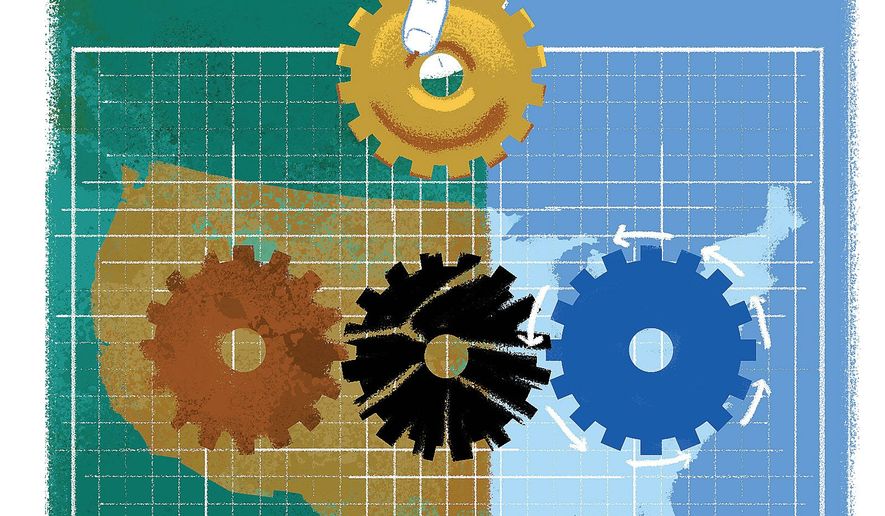OPINION:
When a golden spike was driven into the rails connecting the Central Pacific and Union Pacific railroads at Promontory Summit, Utah Territory on May 10, 1869, interstate railways annihilated distance in the space of one generation and transformed America into a unified nation from coast to coast. The cost for an American to travel across the continent dropped from $1,000 to $150.
President Trump is in the hunt for a new golden spike that will make American infrastructure great again. But the president wants to do more than clean up the “hardened arteries” strangling America’s interior. He wants to administer “bypass surgery.” In the global marketplace of non-stop competition, he knows he needs more than a bullet list for infrastructure development. President Obama tried a piecemeal approach and it failed. The solution is strategic vision to guide capital investment in ways that exploit American market advantage in geography, resources, and governance.
Like the Roman state that shaped and led the political and economic development of the Western world for centuries from its central position in the Mediterranean, America must capitalize on its enviable strategic position straddled by the world’s two largest oceans across which are the Europe and Asian markets. In a world where 90 percent of global exports and imports move by sea, American naval and aerospace supremacy guarantees not only American access to these domains, but access for all nations to the four global commons — the high seas, the atmosphere, Antarctica and outer space.
Beijing wants to build a continental infrastructure of roads, railways, seaports and pipelines through the string of countries along the ancient “Silk Road” route — a noble and praiseworthy endeavor. But conflict, corruption and widespread insecurity across Eurasia pose societal challenges to China’s ambitions. Nation-state interests along the routes will drive up costs.
Unlike the peoples of China, Russia, India and Europe the United States is not threatened by potentially dangerous military opponents in its hemisphere. North America’s interior is secure thanks to the dominance of one people with one language, one culture and one law — namely Americans.
These points suggest a blueprint for U.S. continental infrastructure that rivals the Eisenhower era Interstate system. The golden spike program exploits the trend toward fast and free logistics through autonomous systems, improved power storage (batteries), and “next generation” electric motors. The president can create a new golden spike driven by new technologies that will do for today’s economy what the steam engine did in its time.
This time the golden spike can take the form of a public-private partnership combining capital for innovation with customers dependent on large-scale logistics. This partnership will hasten the “repatriation” of American Manufacturing through the development of intercontinental transport via hyper-efficient sea, air and land-based conveyances that will move goods long distances for pennies per ton. Here is how it can work:
1. Connect major manufacturing hubs at home and abroad with major sea ports and air hubs using a combination of high speed rail, and hyper-efficient ships that lower the cost of travel. Translation: Link Nantes, Bordeaux and Brest with Tokyo, Seoul, Shanghai, Hangzhou, Beijing and Hong Kong through New York, Philadelphia, Charleston, Savannah, Corpus Christi, New Orleans, San Diego, Los Angeles, San Francisco, Portland and Seattle;
2. Redefine “Just in Time Manufacturing.” Identify and develop critical hubs and terminals in the nation’s interior to cultivate manufacturing and restore American national economic competitive advantages over European, Chinese, Korean and Japanese competitors. The redefinition includes the impact of 3d printing: Large-scale shipments will consist of raw materials used for localized production;
3. Exploit “leap ahead” technologies to leverage autonomous systems that bypass traffic and accelerate movement through the “choke points” inside the America’s commercial circulatory system;
4. Restore America’s leadership as a merchant marine power. Building fast ships that operate under the American Flag. A fleet of fast ships on both coasts would revolutionize transportation, and in time of conflict or crisis, provide additional seaborne platforms that can forward-deploy missiles and autonomous aircraft.
5. Augment high-speed rail and maritime infrastructure by creating heavy-lift airborne freight markets. Airships bypass unneeded middlemen with the fastest and most efficient form of unmanned “port to port/door to door” commerce at a cost that is 30 percent less than traditional air freight. They are ideally suited for remote area delivery. Recent patents issued to corporations like Amazon and Walmart illustrate interest in the idea.
To secure U.S. economic power in the 21st century, Mr. Trump knows he must make our infrastructure great again. America’s rise to global power teaches that American economic prosperity is the foundation for U.S. military power. The Golden Spike Project points the way.
• Stephen Burke is chief executive officer and Douglas Macgregor is executive vice president of Burke-Macgregor Group, LLC. Robert Cantrell of Strategy Innovators, LLC, also contributed.




Please read our comment policy before commenting.